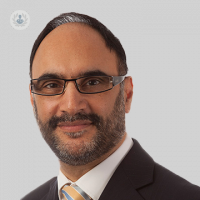Cataract surgery: Which type of lens implant is right for me?
Escrito por:Intraocular lenses implanted during cataract surgery can vastly improve quality of sharpness of vision and in some cases, can allow patients to become glasses-free. With a wide range of lenses available, patients are able to choose the implants that will suit them best, according to their needs and lifestyle. In this informative article, renowned consultant ophthalmologist Mr Saab Bhermi, who specialises in cataract surgery, gives an expert guide to selecting the right intraocular lenses for you.

What is a cataract?
If one compares the eye with a camera, the eye has two lenses, the cornea at the front of the eye and the crystalline lens inside the eye. These help to focus images on the retina at the back of the eye to allow you to see clearly.
When the crystalline lens becomes cloudy, it is called a cataract. The cloudy lens blurs the image falling on the retina and in turn blurs what you can see. Cataracts can also make colours look dull over time and scatter light which produces glare when looking at points of light such as car headlights.
What is an intraocular lens implant?
Cataract surgery replaces the cloudy crystalline lens with a clear intraocular lens implant which restores vision and often makes colours appear much more vividly. There are several types of implants which can be used to replace the natural crystalline lens at the time of surgery which each have their own advantages and disadvantages making them suitable for different people. These include:
- Standard monofocal implants: provide good distance vision but spectacles will still be needed for intermediate and near vision
- Premium toric implants: minimise pre-existing astigmatism and improve distortion allowing a reduction in the strength of spectacles after surgery
- Premium extended depth of focus (EDOF) implants: provide good distance and intermediate (arm’s length) vision which allows for most daily activities without the need for spectacles although reading glasses are still needed for close work
- Premium trifocal implants: aim to provide vision with no need for spectacles following surgery
Some patients require specialist implants which have a combination of either trifocal and toric implants or EDOF and toric lenses for functionality as well as to correct astigmatism and minimise spectacle use.
What type of lens implant should I chose?
It’s important to remember that despite the differences between the different lens implants, once the cataract is removed, they will all improve vision. The decision of which type of lens implant is most suitable for you depends on whether you are happy to wear spectacles most of the time, for reading only, or not at all after surgery. A monofocal implant is required as minimum for most patients but a toric implant will be necessary if the patient has significant astigmatism.
Trifocal implants provide the greatest degree of independence from spectacles. However, they can produce symptoms of halos and glare around car headlights five to ten per cent of patients. If this of particular concern to the patient, for example if they are a professional driver, then an EDOF implant may be a better choice for that individual as it is not associated with these symptoms.
Every patient has unique visual requirements which should be discussed in detail with the surgeon who can then advise a bespoke management plan which will provide the most optimal outcome.
I don’t have a cataract, but I don’t like wearing spectacles. Can cataract surgery help me?
Some people need spectacles to see well if the natural lenses of their eye cannot focus a clear image on the retina. In most patients, once they reach the age of around fifty, the crystalline lens becomes stiff and cannot focus on near objects meaning reading spectacles are needed for close work. Some patients find wearing spectacles inconvenient or they interfere with hobbies and sports.
For these patients, removing the crystalline lens and replacing it with an implant which correctly focuses images on the retina will minimise the need for regular spectacles. If an EDOF or trifocal implant is used, then reading spectacles are also not needed. This type of surgery is often called presbyopic lens exchange (PRELEX) and is essentially the same as cataract surgery.
I have already had cataract surgery with a standard monofocal lens implants in the past and don’t like using reading glasses. Is there anything I can do?
Yes, there is. Specially adapted trifocal or trifocal or toric secondary implants can be placed in front of the original monofocal implant which is already in the eye. This is similar to having your reading glasses placed inside the eye. This provides good distance, intermediate and near vision, minimising the need for spectacles.
If you are considering cataract surgery and wish to discuss your options further, don’t hesitate to book a consultation with Mr Bhermi by visiting his Top Doctors profile.


